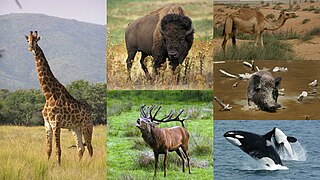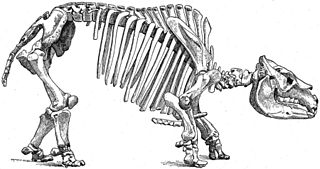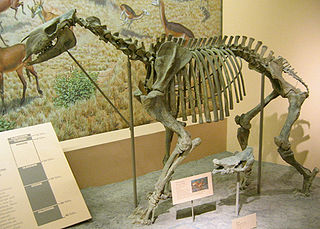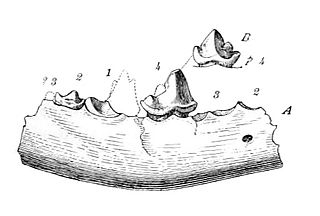
Ancylopoda is a group of browsing, herbivorous, mammals in the Perissodactyla that show long, curved and cleft claws. Morphological evidence indicates the Ancylopoda diverged from the tapirs, rhinoceroses and horses (Euperissodactyla) after the Brontotheria; however, earlier authorities such as Osborn sometimes considered the Ancylopoda to be outside Perissodactyla or, as was popular more recently, to be related to Brontotheriidae.

Perissodactyla is an order of ungulates. The order includes about 17 living species divided into three families: Equidae, Rhinocerotidae (rhinoceroses), and Tapiridae (tapirs). They typically have reduced the weight-bearing toes to three or one of the five original toes, though tapirs retain four toes on their front feet. The nonweight-bearing toes are either present, absent, vestigial, or positioned posteriorly. By contrast, artiodactyls bear most of their weight equally on four or two of the five toes: their third and fourth toes. Another difference between the two is that perissodactyls digest plant cellulose in their intestines, rather than in one or more stomach chambers as artiodactyls, with the exception of Suina, do.

Ungulates are members of the diverse clade Euungulata, which primarily consists of large mammals with hooves. Once part of the clade "Ungulata" along with the clade Paenungulata, "Ungulata" has since been determined to be a polyphyletic and thereby invalid clade based on molecular data. As a result, true ungulates had since been reclassified to the newer clade Euungulata in 2001 within the clade Laurasiatheria while Paenungulata has been reclassified to a distant clade Afrotheria. Living ungulates are divided into two orders: Perissodactyla including equines, rhinoceroses, and tapirs; and Artiodactyla including cattle, antelope, pigs, giraffes, camels, sheep, deer, and hippopotamuses, among others. Cetaceans such as whales, dolphins, and porpoises are also classified as artiodactyls, although they do not have hooves. Most terrestrial ungulates use the hoofed tips of their toes to support their body weight while standing or moving. Two other orders of ungulates, Notoungulata and Litopterna, both native to South America, became extinct at the end of the Pleistocene, around 12,000 years ago.

Artiodactyls are placental mammals belonging to the order Artiodactyla. Typically, they are ungulates which bear weight equally on two of their five toes. The other three toes are either present, absent, vestigial, or pointing posteriorly. By contrast, most perissodactyls bear weight on an odd number of the five toes. Another difference between the two orders is that many artiodactyls digest plant cellulose in one or more stomach chambers rather than in their intestine. Molecular biology, along with new fossil discoveries, has found that cetaceans fall within this taxonomic branch, being most closely related to hippopotamuses. Some modern taxonomists thus apply the name Cetartiodactyla to this group, while others opt to include cetaceans within the existing name of Artiodactyla. Some researchers use "even-toed ungulates" to exclude cetaceans and only include terrestrial artiodactyls, making the term paraphyletic in nature.

Moropus is an extinct genus of large perissodactyl mammal in the chalicothere family. They were endemic to North America during the Miocene from ~20.4–13.6 Mya, existing for approximately 6.8 million years. Moropus belonged to the schizotheriine subfamily of chalicotheres, and has the best fossil record of any member of this group; numbers of individuals, including complete skeletons, have been found.

Notoungulata is an extinct order of ungulates that inhabited South America from the early Paleocene to the end of the Pleistocene, living from approximately 61 million to 11,000 years ago. Notoungulates were morphologically diverse, with forms resembling animals as disparate as rabbits and rhinoceroses. Notoungulata are the largest group of South American native ungulates, with over 150 genera in 14 families having been described, divided into two major subgroupings, Typotheria and Toxodontia. Notoungulates first diversified during the Eocene. Their diversity declined from the late Neogene onwards, with only the large toxodontids persisting until the end of the Pleistocene, perishing as part of the Late Pleistocene megafauna extinctions along with most other large mammals across the Americas. Collagen sequence analysis suggests that notoungulates are closely related to litopterns, another group of South American ungulates, and their closest living relatives being perissodactyls, including rhinoceroses, tapirs and equines as part of the clade Panperissodactyla. However their relationships to other South American ungulates are uncertain. Several groups of notoungulates separately evolved ever-growing cheek teeth.

Chalicotheriidae is an extinct family of herbivorous, odd-toed ungulate (perissodactyl) mammals that lived in North America, Eurasia, and Africa from the Middle Eocene to the Early Pleistocene. They are often called chalicotheres, a term which is also applied to the broader grouping of Chalicotherioidea. They are noted for their unusual morphology compared to other ungulates, such as their clawed forelimbs. Members of the subfamily Chalicotheriinae developed elongate gorilla-like forelimbs that are thought to have been used to grasp vegetation. They are thought to have been browsers on foliage as well as possibly bark and fruit.

Stylinodon is an extinct genus of taeniodonts from extinct tribe Stylinodontini within subfamily Stylinodontinae and family Stylinodontidae, that lived in North America from early to middle Eocene.

Barylambda is an extinct genus of pantodont mammal from the middle to late Paleocene, well known from several finds in the Wasatchian DeBeque Formation of Colorado and the Clarkforkian Wasatch Formation to Tiffanian Fort Union Formation in Wyoming. Three species of Barylambda are currently recognized. The creature likely lived a life similar to that of a modern tapir, browsing on foliage and soft vegetation. Barylambda seems to have been quite successful for an early pantodont, though eventually it seems to have been replaced in its ecosystem by other pantodonts, such as Coryphodon.
Eomoropidae is a family of odd-toed ungulates, a group which also includes horses, rhinoceroses, and tapirs. They were most closely related to the extinct chalicotheres, which they greatly resemble, and may have been their immediate ancestors. They were, however, much smaller than the later forms, being around the size of a sheep. Like their later relatives, they were probably browsers on leaves and other soft vegetation, and, unlike most other ungulates, had claws on their feet. The Eomoropidae is most likely a paraphyletic group within Chalicotherioidea.

Palaearctonyx is an extinct genus of omnivorous placental mammals from clade Carnivoraformes, that lived in North America from the early to middle Eocene.

Prodaphaenus is an extinct genus of placental mammals from clade Carnivoraformes, that lived in North America during the middle Eocene.

Bryanictis is an extinct genus of placental mammals from extinct subfamily Didymictinae within extinct family Viverravidae, that lived in North America, from the early to late Paleocene.
Intyrictis is an extinct genus of placental mammals from extinct subfamily Didymictinae within extinct family Viverravidae, that lived in North America during the early Paleocene.
Pristinictis is an extinct genus of placental mammals from extinct subfamily Didymictinae within extinct family Viverravidae, that lived in North America during middle Paleocene.

Procynodictis is an extinct genus of placental mammals from clade Carnivoraformes, that lived in North America from the early to middle Eocene.

Raphictis is an extinct genus of placental mammals from extinct subfamily Didymictinae within extinct family Viverravidae, that lived in North America during late Paleocene.

Hypohippus is an extinct genus of three-toed horse, which lived 17–11 million years ago. It was the largest anchitherine equid about the size of a modern domestic horse, at 403–600 kg (888–1,323 lb) and 1.8 m (5.9 ft) long. It was a long-necked, high-shouldered browser with sub-hypsodont, lophodont (rhino-like) dentition, that fed on the tough vegetation of forest understory and shrubs. Its deep preorbital fossae and retraction of the nasal notch hint at the presence of a long, muscular and prehensile upper lip that would aid during selective browsing. Overall its ecology would have been more comparable to modern okapi than to grazing horses. Fossils of it have been found in Nebraska, Colorado, and Montana.

Psittacotherium is an extinct genus of taeniodonts from extinct tribe Psittacotheriini within subfamily Stylinodontinae and family Stylinodontidae, that lived in North America from early to late Paleocene. With a weight between 35.6 kg (78 lb) and 71.2 kg (157 lb), and length of 1.125 m, it had similar size of a large dog.

Hemipsalodon is an extinct genus of hyainailourid hyaenodonts from the subfamily Hyainailourinae that lived in North America during the middle to late Eocene.



















